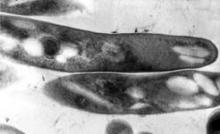Adding bedaquiline to a five-drug background regimen for multidrug-resistant pulmonary tuberculosis significantly accelerated the time at which sputum cultures showed clearance of Mycobacterium tuberculosis in a phase IIb clinical trial, which was published online Aug. 21 in the New England Journal of Medicine.
The addition of 6 months of oral bedaquiline – a diarylquinoline that inhibits mycobacterial ATP synthase and depletes cellular energy stores – also significantly increased the number of patients who achieved such culture conversion (a surrogate for clinical cure), compared with adding placebo, in this industry-sponsored study. Bedaquiline "is the first antituberculosis drug with a new mechanism of action to be approved for use in multidrug-resistant TB in 40 years," said Dr. Andreas H. Diacon of the National Research Foundation Centre of Excellence for Biomedical Tuberculosis Research at Stellenbosch University in Cape Town, South Africa, and his associates.
Bedaquiline was approved in 2012 under the Food and Drug Administration’s accelerated-approval regulations for drugs that provide meaningful therapeutic benefit over existing therapies for serious or life-threatening conditions. The drug is approved only for patients for whom an effective treatment regimen cannot be constructed without it, a population in whom the benefits outweigh the risks.
In the trial, 160 adults with multidrug-resistant pulmonary TB were randomly assigned to receive either oral bedaquiline (79 patients) or matching placebo tablets (81 patients) for 24 weeks at medical centers in Brazil, India, Latvia, Peru, the Philippines, Russia, South Africa, and Thailand, in addition to the five-drug background regimen of antituberculosis drugs preferred at each location. They continued the background therapy for a further 96 weeks and had a final follow-up exam at the conclusion of that treatment. Sixty participants (38%) left the study prematurely, usually because of withdrawal of consent, adverse effects, nonadherence, loss to follow-up, and pregnancy. The number of and reasons for these discontinuations were similar between the two study groups.
The primary endpoint of the study was the median time to sputum conversion. This was significantly faster in the intervention group (83 days) than in the control group (125 days) in both the modified intention-to-treat analysis and the full intention-to-treat analysis. Moreover, more patients in the intervention group (79%) than in the placebo group (58%) showed culture conversion at 24 weeks, as well as at 120 weeks (62% vs 44%). And according to the World Health Organization definition of "cure," nearly twice as many patients in the bedaquiline group (58%) were cured as in the placebo group (32%) at 120 weeks, Dr. Diacon and his associates said (N. Engl. J. Med. 2014;371:723-32 [doi:10.1056/NEJMoa1313865]).
Fewer patients taking bedaquiline (2) than taking placebo (16) developed new resistance to at least one antituberculosis agent during the study. Rates, types, and severity of adverse events were comparable between the two study groups. However, mortality was significantly higher with bedaquiline (10 patients, 13% mortality) than with placebo (2 patients, 2% mortality), for reasons that are not yet understood but do not appear to be related to the study drug.
"A planned phase III study will enroll a larger number of patients, including HIV-positive patients receiving antiretroviral therapy," the investigators noted.
This study was funded by Janssen Pharmaceuticals. Dr. Diacon reported no financial conflicts of interest. His associates reported ties to Janssen; to its parent company, Johnson & Johnson; and to Quintiles.

